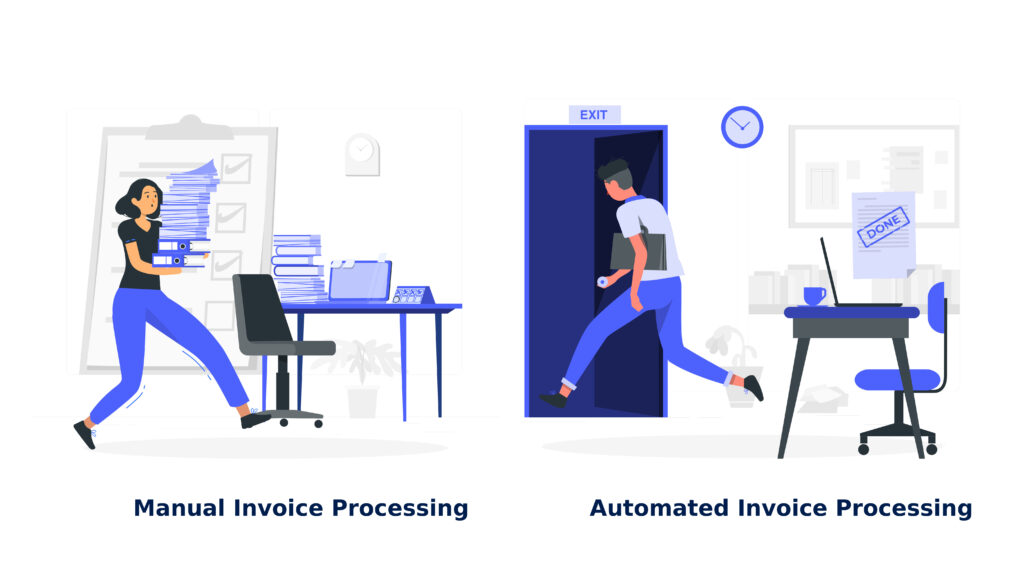Manual invoicing and invoicing software are the two main methods available to organisations and individuals when managing their finances and collecting payment for goods or services supplied. Manual invoicing means creating invoices using fundamental digital technologies like spreadsheets or paper. Contrarily, billing software automates invoicing – from creating invoices to monitoring payments. Both approaches have advantages and disadvantages, and their choice mainly depends on personal preferences. In this article, we’ll explore the pros and cons of manual invoicing and billing software to help you determine which option best suits your business needs.

Manual Invoicing: The Traditional Approach
The traditional, non-automated method of preparing, issuing, and handling invoices without specialised billing software or automated processes is called manual invoicing. Invoices are produced manually on paper or digitally using necessary programs like word processors or spreadsheet applications. This procedure typically entails entering the relevant invoice information into a document, including the description of the goods or services, quantities, prices, taxes, and payment terms.
Additionally, manual invoicing may entail printing hard copies of invoices to mail to clients or customers. The invoices are only used to track payments and ensure that bills are paid on time; all follow-ups or reminders are handled manually.
Invoicing Software
A specific computer program or application called invoicing or billing software is made to automate and streamline commercial billing and invoicing procedures. It is a digital application that replaces laborious and time-consuming tasks related to issuing invoices, tracking payments, and managing financial data. Invoice generating, customisation, and electronic transmission to clients or customers are just a few of the services that billing software offers. It can apply discounts, calculate taxes automatically, and maintain thorough records of every transaction. Additionally, billing software frequently provides features like payment reminders, late charge computations, and the creation of financial reports, enabling firms to manage their cash flow effectively and remain organised. Billing software is a valuable tool that saves time, lowers the possibility of errors, and benefits freelancers, small businesses, and major corporations.
Manual Invoicing Vs. Invoicing Software
There are benefits and drawbacks to manual invoicing and billing software for handling the invoicing process. A thorough comparison between them is given below:
Pros of Manual Invoicing
- Low Initial Cost: Manual invoicing requires no or little investment cost as it doesn’t require any software or technology. It can be created using the Word processors or spreadsheet tools you already have on your computer.
- Personal Touch: Manual invoicing must be created from scratch to easily customise each invoice to cater to the client’s specific needs and preferences.
- No Training Required: There is no need for training as it is straightforward, and if you’re familiar with Word processors or spreadsheets, you can start creating invoices immediately.
- Control: Everything is under your control in manual invoicing, from design to data entry, which can be valuable for businesses with unique requirements.
Cons of Manual Invoicing
- Time-Consuming: Manual invoicing is very tedious and time-consuming. It involves data entry, handling paperwork, sending invoices and keeping track of payments manually, which can be very confusing and error-prone.
- Higher Error Risk: Manual invoicing is at higher risk of human errors such as miscalculations, missing details or forgetting to send invoices on time, leading to billing disputes, delayed payments, and a strained client relationship.
- Limited Automation: Manual invoicing lacks automation features, such as payment reminders and recurring billing, which can improve efficiency.
Pros of Invoicing Software
- Automation: Billing software automates the entire invoicing process. It can handle recurring invoices, send automated payment reminders, and even generate financial reports, streamlining your workflow.
- Accuracy: The billing software minimises errors, performs calculations automatically, and ensures invoice consistency.
- Scalability: Billing software scales effortlessly with your business. You can handle a large number of invoices and clients without added stress.
- Analytics: Many billing software options offer built-in reporting and analytics tools, providing insights into your financial health and client payment patterns.
- Efficiency: Billing software automates invoicing, from generating invoices to tracking payments. This automation can save you valuable time and reduce the risk of errors.
- Improved Accuracy: The invoicing or billing software ensures accurate calculations, reducing the likelihood of invoicing mistakes and disputes.
- Accessibility: Billing software provides access to your data anywhere and anytime, making it convenient for businesses with remote teams or multiple locations.
Cons of Invoicing Software
- Cost: Billing software comes with an initial cost or ongoing subscription fees. However, the time and money saved by automating your invoicing process often outweigh these expenses.
- Learning Curve: Users may need some time to get used to the technicalities of the billing software. Depending on the billing software, it requires basic to extensive training to use the software.
Which is Better?
Manual invoicing may be sufficient for small businesses with few bills and those who prefer a hands-on approach to invoicing. But with the growing business, it can be time-consuming and error-prone, for which you will need a more efficient tool for invoicing.
Billing software is the way for medium-sized to large organisations or those looking for precision and efficiency in invoicing. Even while there is an initial learning curve and cost, there are significant long-term advantages in terms of time savings and better financial management.
Manual methods could be adequate for small enterprises with basic invoicing needs. However, billing software’s efficiency, precision, and scalability become more valuable as your firm expands, making it a wise investment for many businesses.
FAQs
How is manual invoicing different from invoicing software?
Creating invoices manually entails writing or typing the invoice information on paper. However, billing software streamlines the invoice creation, transmission, and tracking processes by giving users access to digital resources.
Is invoicing software suitable for all businesses?
Businesses of all sizes can gain from using invoicing or billing software. Small businesses can use it to automate their billing procedures, while larger firms can use the additional capabilities for scalability and effectiveness.
What are the advantages of manual invoicing?
Manual billing provides more control over data entry, better safeguards sensitive data, and prevents understanding complicated billing software.
What are the benefits of using invoicing or billing software?
Invoicing or billing software has several advantages, such as creating invoices and delivery automation, faster payment processing, simple tracking of payments and unpaid invoices, expert invoice templates, and integration with accounting software for smooth record-keeping.







Leave a Comment
You must be logged in to post a comment.